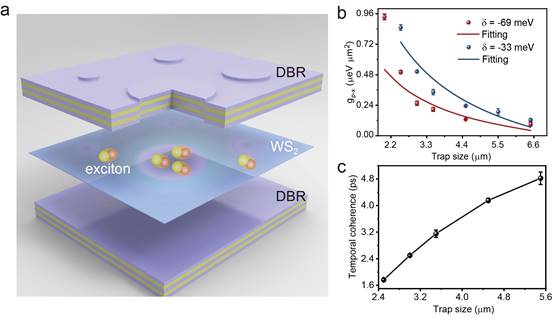Exciton polaritons, hybrid quasiparticles caused by the strong exciton-photon coupling, constitute a unique prototype for studying many-body physics and quantum photonic phenomena traditionally in cryogenic conditions. Atomically thin transition-metal dichalcogenides (TMDs), as exceptional semiconductors with room-temperature operations, have received much attention due to their fascinating valleytronics features and strong exciton resonance. Nevertheless, in TMDs microcavities, the overall nonlinear interaction strength of polaritons can be insignificant compared to that of other wide-bandgap semiconductors. Considerable effort has been devoted to improving the nonlinear interactions, for instance, by resorting to 2s states, trion, and moiré or dipolar excitons. However, these excitons quickly dissipate at elevated temperatures and then destroy the strong coupling condition. Thus, achieving an appropriate combination of strong nonlinearity together with the thermal stability of the TMDs polaritons is highly sought after for realistic polariton-based integrated devices.
In a recent paper published in Light Science & Application, a team of scientists, led by Professor Qihua Xiong from the State Key Laboratory of Low-Dimensional Quantum Physics, Department of Physics, Tsinghua University, China, Beijing Academy of Quantum Information Sciences, China, and co-workers have presented fully deterministic potential wells via the lithographic mesas to trap polaritons through the photonic component in a monolayer WS2 microcavity. Experimentally, their mesa cavities show the discretization of photoluminescence dispersions and spatially confined patterns, unambiguously demonstrating the deterministic on-site trapping effect. More interestingly, they have systematically studied the polariton nonlinearity under such cavities by non-resonant power-dependent measurements and found that the polariton-exciton interaction dominates the observed spectral shift, which can be increased by about six times through improving spatial confinement at room temperature. Meanwhile, the coherence of trapped polaritons is significantly improved due to the spectral narrowing and tailored in a picosecond range. Therefore, these results prove a convenient method based on the programmed micro-nano fabrication to achieve controllable nonlinearity and coherence of polaritons in TMD at room temperatures, opening new avenues for future polariton-based integrated devices, such as polariton modulators, polariton quantum sources, and quantum neural networks. These scientists summarize the innovation and significance of their work:
“Employing the artificial mesa cavities to manipulate interacting exciton polaritons has three prominent advantages. First, the approach allows to operate at ambient conditions, which is highly sought after for realistic polariton-based integrated devices. Second, the mesa cavities will confine polaritons through their photonic part instead of the excitonic part, which is more practical considering the extremely small Bohr radius and a sub-micrometer transport length of excitons. Last, the utilization of mesa cavities enables us to realize fully deterministic potential wells rather than random traps probably induced by strain or air gaps involved in sample preparation.”

Figure | Controllable nonlinearity and coherence of polaritons in monolayer TMDs mesa cavities
a, Schematic of monolayer WS2 embedded in two DBRs with cylindrical mesa structures. The exciton-polaritons are trapped in the artificial confinement potential. b, The estimated polariton-exciton interaction strength versus trap size at the detuning of -33 meV (blue) and -69 meV (red). All the experimental results show that artificially creating potential landscapes is an encouraging strategy for enhancing polariton-exciton interaction strengths. c, Coherence time as a function of trap size in the cavity, indicating that the increased polariton-reservoir interaction for the tighter confinement would accelerate the decoherence rate of polaritons and shorten the coherence time. The error bars correspond to the exponential fitting uncertainty.
“This work indicates the feasibility of controlling polariton properties in TMDs microcavities by engineering artificial potential wells and establishes the foundation for simulating the polariton Hamiltonian with further complex potential landscapes and realizing integrated polaritonic devices at room temperature.” the scientists forecast.